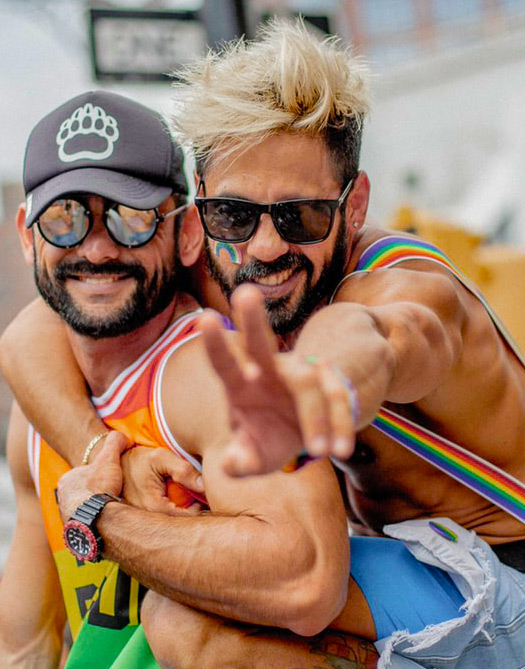It’s happened a thousand times: I’m walking down Santa Monica Boulevard running weekend errands with my husband in West Hollywood and an Adonic god walks past us on the sidewalk. Rugged jawline, big biceps, triceps and quads. He is beauty personified.
Moments later, feeling shamefully inadequate, I turn to my husband and ask, “I’m pretty enough for you, aren’t I?”. He does his best to reassure me and we continue on our way. Nevertheless, I avoid looking through the windows of the 24-Hour Fitness that we’re approaching, both to avoid seeing the flawless bodies inside and my own flawed reflection.
Body Dysmorphic Disorder (BDD) is a psychological diagnosis involving a preoccupation with one’s looks. Classified as an obsessive-compulsive disorder in the DSM-V, symptoms typically include repetitive behaviors like mirror-checking, excessive working out, seeking reassurance about one’s looks and an obsession with diet.
In our celebrity-mad culture, BDD is over-represented in women, however, studies are showing a huge prevalence amongst same-sex attracted men. According to the OCD & Related Disorders Program at Massachusetts General Hospital, there is a 32% prevalence rate of body dissatisfaction among gay men, compared to 24%, 35%, and 38% for heterosexual men, lesbians, and heterosexual women, respectively. Furthermore, gay men comprise an estimated 2-4% of the US population, however, they represent 12.5% of all men with BDD.
Being gay and living in WeHo, the center of gay life in Southern California, it’s not hard to see why we are over-represented. I’ve met many queer men who hold incredibly high standards of beauty and what and who is sexually attractive: You need to be big and small in all the right places! I’m reminded of this every day when I drive past billboards across Los Angeles, advertising everything from hook-up apps to fashion labels to cosmetic surgery, featuring men with perfect physiques – big muscles and skinny waistlines – in nothing more than their bathing suits or underwear. Head to most gay bars on any night of the week and it’s like those men on the billboards have come alive, but now they’re dancing for cash or serving you drinks. Being a gay man in a very gay part of town, it seems impossible to escape this bombardment of male beauty. It can be both wonderful and exhausting – what gay man doesn’t enjoy the male form in all it’s splendor? But on the other hand, I feel like I must make sure I’m looking my best before doing something as mundane as checking the mailbox!
Pornography and BDD
Then there’s porn. Since its mainstream emergence in the 1970s, pornography has played a unique, liberating role in gay life. In parts of the world where living openly gay could result in discrimination, ridicule or even put one’s life in danger, pornography has allowed my queer brothers to safely explore their sexual fantasies. With this in mind, it shouldn’t be all that surprising that same-sex attracted men are big consumers of pornography – it’s claimed that between 96-99% of us watch porn, compared to 72-76% of straight men. Heck, at some of my local gay bars, porn is played on TV monitors all night long!
The days of the shameful walk to the video store or newsstand to buy porn have passed, though not so long ago that this author has forgotten. Nowadays, thanks to the internet and smartphones, we only need to type a few letters into Google to find a buffet of all the porn you could imagine catering to every audience, fetish and kink. Talk about convenience!
And I’m a big believer of sex positivity. Sex is orgasmically fun and one of the great gifts of life. Porn can also spice up a tired sex life. But with its rather unrealistic expectations, could porn also be contributing to the increased occurrence of BDD among same-sex attracted men?
Experts are saying yes. A 2017 study published in the Archives of Sexual Behavior surveyed 1,071 gay and bisexual men measuring levels of porn consumption and its correlation with male body attitudes, anxiety and depression. The study’s participants reported viewing 3 hours of porn per week on average. Greater consumption of porn was directly related to increased negative body attitudes and both depressive and anxious symptomology.
So, where to?
To readers exhibiting symptoms that may be associated with Body Dysmorphic Disorder, especially my queer brothers, I encourage you to find support. Having dealt with depression myself, I have always sought out a primary care doctor who understands both mental illness and LGBT health, a doctor that is nonjudgmental who I can discuss my symptoms with and who can refer me on to a mental health professional when my condition warrants.
Understandably, some same-sex attracted men may have difficulty discussing their sexuality with their doctor – perhaps out of fear of prejudice – and some may have limited access to affirming health services. I would therefore encourage you to seek out organizations or agencies to help you – start with LGBT centers, like the Los Angeles LGBT Center (who provide health and mental health services and support, including groups, among other activities) and sexual health clinics serving LGBT clients that can help you find the right support. The Center for Disease Control maintains an excellent list of LGBT health clinics across the US.
You are not alone!
If you are living with Body Dysmorphic Disorder, or even just experiencing known symptoms of BDD, take comfort knowing that you are not the only one. It is very common among queer men – out Olympic figure skater Adam Rippon has spoken openly about his struggles with BDD, for example. And you know those perfect men in porn? Not even they are immune to Body Dysmorphic Disorder.
Further Reading
- Thirst Trapped: The Struggle for Body Acceptance within the Gay Community by Jesús Alvarado, USC StorySpace
- Why Do Gay Men Hate Their Bodies? by Michael Love Michael, Paper
- What is BDD – International OCD Foundation


